Thermal Tips: How to Smoke a Whole Duck
Holidays and special occasions are more memorable with an exceptional meal. If you’d like to try something a little different yet still elegant, consider a smoked duck! Rich, flavorful duck slow-cooked on a smoker is an out-of-the-ordinary main dish that is sure to please. We have all the thermal secrets you need for smoked duck success.
What Makes Duck Meat Different?
Ducks have the ability to fly hundreds of miles a day, and their muscles are rich in myoglobin because of all the activity. Not only do ducks fly, but they swim. They have a thick layer of fat over their breasts for buoyancy. Duck meat is dark, moist, and full of rich flavor. If the dark turkey meat is your favorite at Thanksgiving, give duck a try. You’ll be in for a treat!
Only One Type of Meat on the Bird
The tricky thing about cooking a whole chicken or turkey is balancing the doneness of the dark leg meat and the lean white meat of the breasts (see our info on, White vs. Dark Turkey Cooking Methods). But duck is ALL dark meat, making it less finicky to cook. You just need the right cooking temperature to properly dissolve the fat.
➤ Duck Cooking Temperature
Traditional smoking temperatures are quite low—200-275°F (93-135°C). But duck needs a higher temperature to render the fat well. A cooking temperature of about 300°F (149°C°C) is recommended.
➤ Duck Doneness Temperature
Duck has the same minimum doneness temperature as other poultry—165°F (74°C). Tracking the duck’s temperature during the cook, and verifying its pull temperature are important steps in the quality of the cooked meat and its safety.
Is Cooked Duck Safe Even if It’s Pink?
If fresh duck or goose has reached a safe minimum internal temperature of 165°F (74°C) as measured with a food thermometer, even though it may still be pink in the center, it should be safe. The pink color can be due to the cooking method or added ingredients. —Duck and Goose From Farm to Table, USDA.gov
But, according to the USDA’s Time-Temperature Pasteurization Tables, poultry only needs to be held at a temperature of 157°F (69°C) for 50.4 seconds to be considered pasteurized and safe to eat (with a 7-log reduction of pathogens). At 160°F (71°C), the temperature only needs to be maintained for 26.9 seconds.
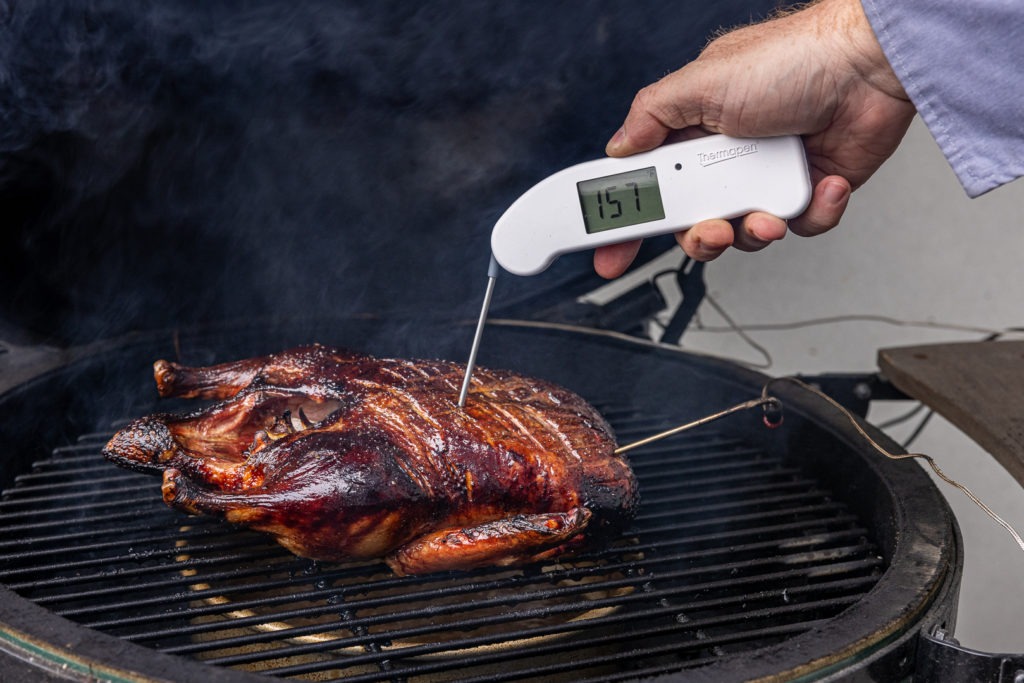
Dark poultry meat can still look pink when it has been cooked to a safe internal temperature, but especially when it has been smoked. If you’ve been able to verify the duck’s internal temperature with an accurate thermometer, then rest assured it’s safe to eat.
Quick Smoking Project
Ducks are small (5-1/2–6 lbs.), so this bird doesn’t take nearly as long to smoke as a turkey. It’ll be ready for your holiday dinner in 2-3 hours. Our duck was perfectly cooked in 2-1/2 hours.
Recommended Temperature Tools
➤ Dual-Channel Alarm Thermometer
We love using Smoke X2™ with its dual channels to track both the temperature of the meat and the temperature of your cooker at the same time. The wireless receiver is a lifesaver when it’s cold outside—you can keep an eye on both temperatures while keeping warm indoors!
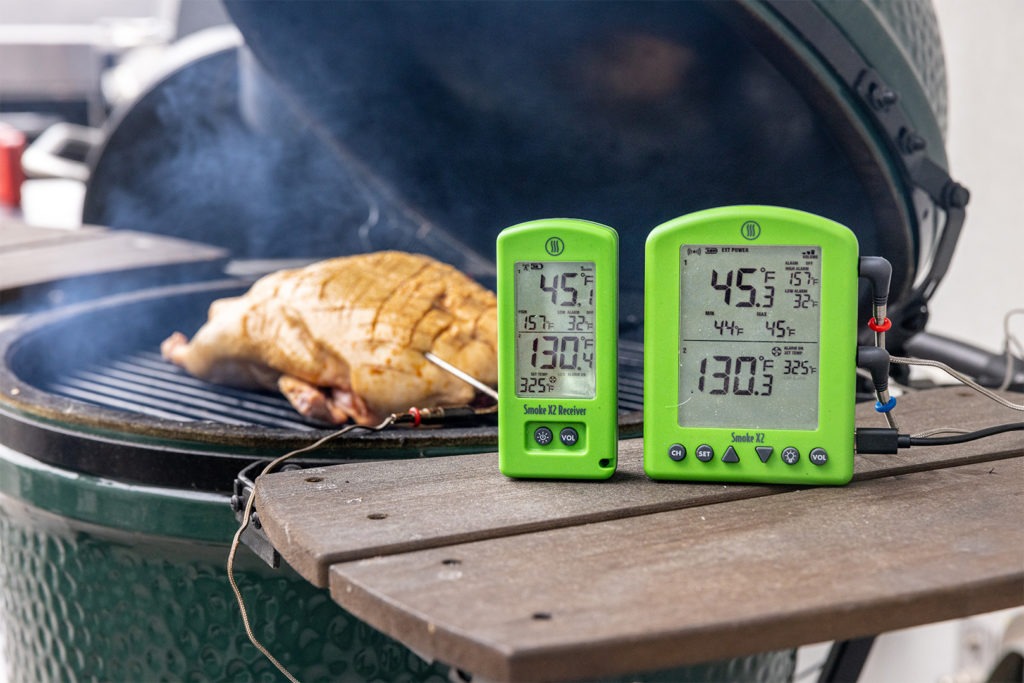
➤ Digital Instant-Read
It’s important to always verify that your target temperature is the lowest temperature inside the meat. When you’re smoking meat it’s important to only open the lid as little as possible to maintain an even smoking temperature. The speed and accuracy of a Thermapen® ONE can’t be beat, and will keep your temperature spot-checking time down to a minimum.
Smoked Duck Recipe
We used a smoked duck recipe from BBQ Pitmaster Malcolm Reed of How to BBQ Right.
Ingredients
- 5–6 lb. whole duck
- 2 tablespoons honey
- 1 tablespoon soy sauce
- 1 small onion, quartered
- 2 small mandarin oranges, quartered
- Salt and pepper as needed to season the duck
For Glaze
- 1 tablespoon honey
- 1 tablespoon molasses
- 2 tablespoons orange juice
- 1 tablespoon balsamic vinegar
- Zest of one orange
- Pinch of salt and pepper
Equipment
- Smoker setup
- Smoke dual-channel alarm thermometer with wireless receiver
- Pro-Series High Temp Straight Penetration Probe
- Thermapen
- Apple (or cherry) wood chips or chunks
Instructions
Prep the Day Before
- Trim the skin around the neck leaving about a 1″ flap, and remove the tips of the wings.
- Remove giblets from the duck’s cavity, and pat the duck dry with paper towels.
- Pierce or slash skin all the way through the fat layer without going through to the meat in about 1″ intervals to help the fat render out.
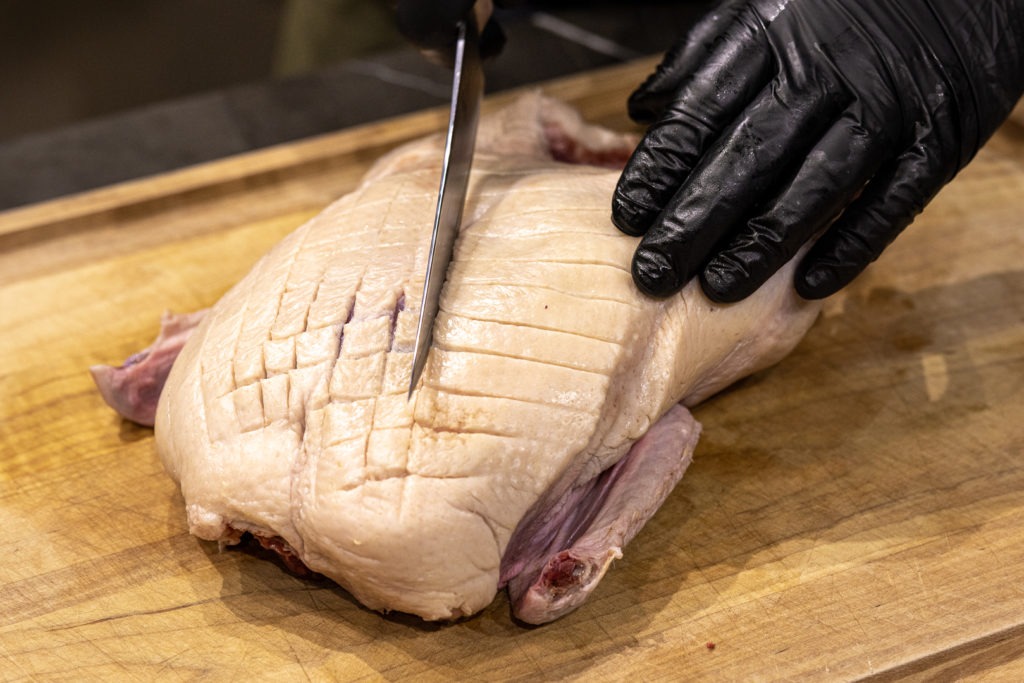
- Brush with 2 tablespoons honey and 1 tablespoon soy sauce.
- Season with salt and pepper on all sides
- Stuff the duck’s cavity with a quartered mandarin orange and onion.
- Place onto metal cooling grate set over a rimmed baking sheet.
- Refrigerate overnight, uncovered, to dry brine.
Cook Day
Fire up Your Smoker
- Connect Billows™ BBQ Control Fan to the smoker and set the temperature for somehwere in the range of 300-325°F (149-163°C) on your Smoke X2. Add wood chips or chunks.
- Place a water pan below the smoker’s cooking grate to create a humid environment, and to catch the copious drips.
- Set cooking grate in place and secure the air probe with a grate clip.
- Close the smoker lid and let smoke develop for about 20 minutes.
Glaze the Duck
- While your smoker is heating, make the glaze. In a small bowl combine the honey, molasses, orange juice, balsamic vinegar, orange zest, and salt and pepper. Liberally brush the glaze all over the duck.
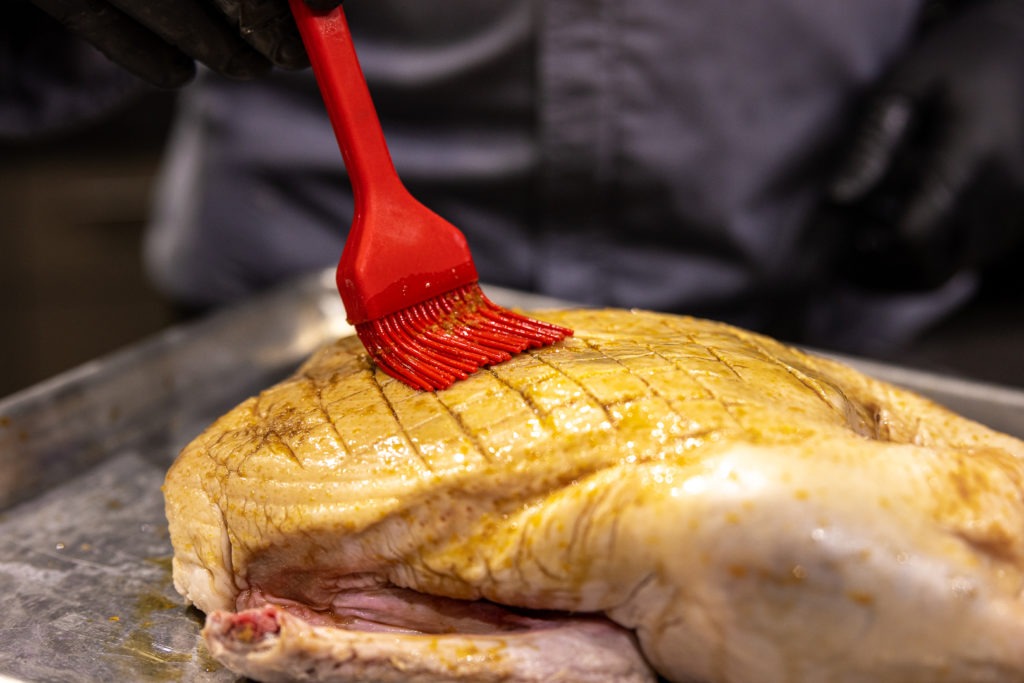
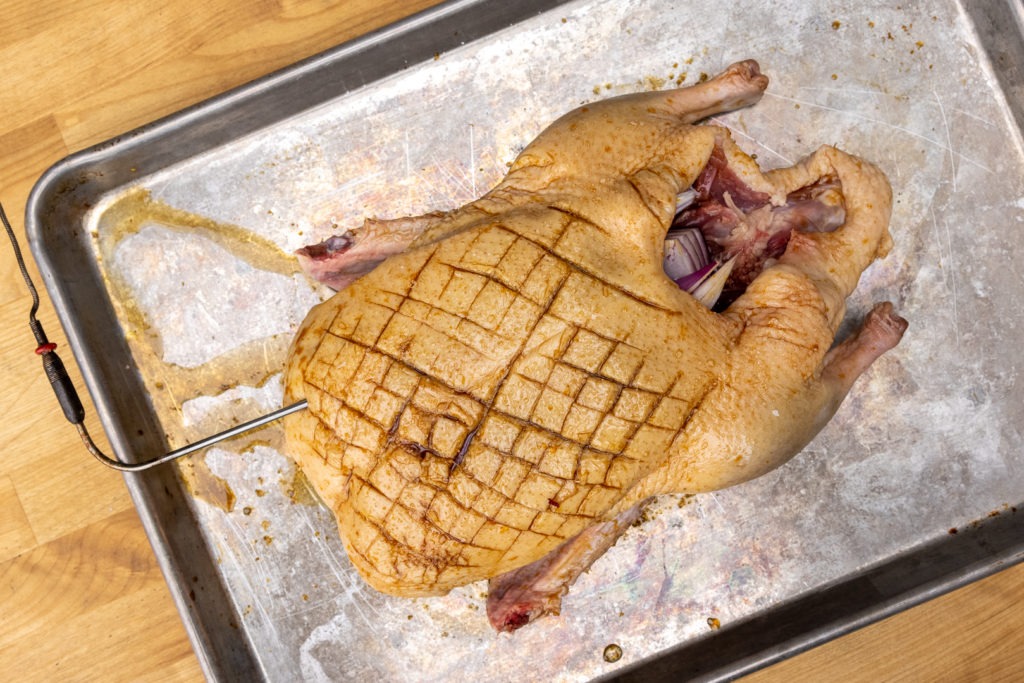
Cook the Bird
- Set Smoke’s high alarm to 157°F (69°C) on the channel monitoring the meat. Set the high alarm to 330°F (166°C) on the channel monitoring the smoker’s temperature, and the low alarm to 295°F (146°C).
- Place your Pro-Series® High Temp Straight Penetration Probe in the thermal center of the breast meat.
- Set the duck onto the cooking grate, close the smoker lid, and smoke.
- Keep your receiver around your neck and go back inside to warm up! You’ll never have to wonder what’s going on with your smoker or the meat. The receiver will alert you if the cooker’s temperature is too high or low, and when the meat has reached its target temperature. Easy! Our duck took about 2-1/2 hours to smoke.
- When the meat’s high alarm sounds, verify its internal temperature by spot-checking it with your Thermapen in multiple areas. If a lower temperature than 157°F (69°C) is found, replace the Pro-Series probe, close your smoker’s lid and keep cooking the duck until the target temperature is reached.
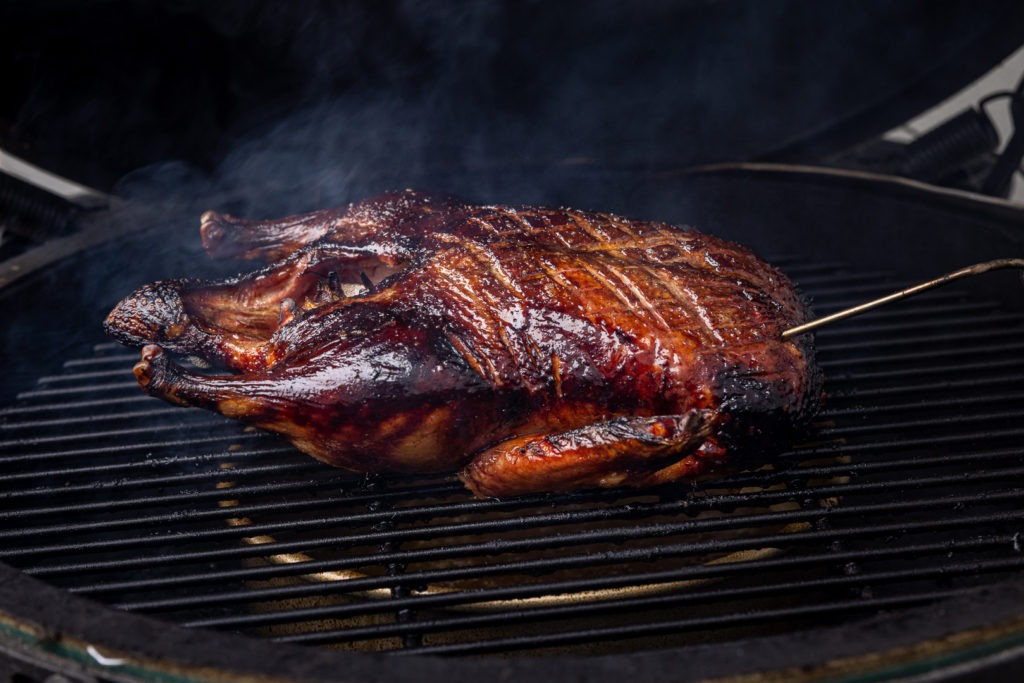
Resting and Carryover
Pull the duck from your smoker when the pull temperature is verified and let it rest for 15-20 minutes.
Once your beautiful smoked duck has rested, it’s the moment you’ve been waiting for—time to carve and serve. The perfectly cooked meat is tender and incredibly juicy. This smoked duck is packed with so much rich flavor, and it’s an ideal choice as the centerpiece of any holiday dinner.
Shop now for products used in this post:
Resources:How to Smoke a Whole Duck, How to BBQ Right, Malcolm ReedUSDA Time-Temperature Tables for Cooking Ready-To-Eat Poultry Products


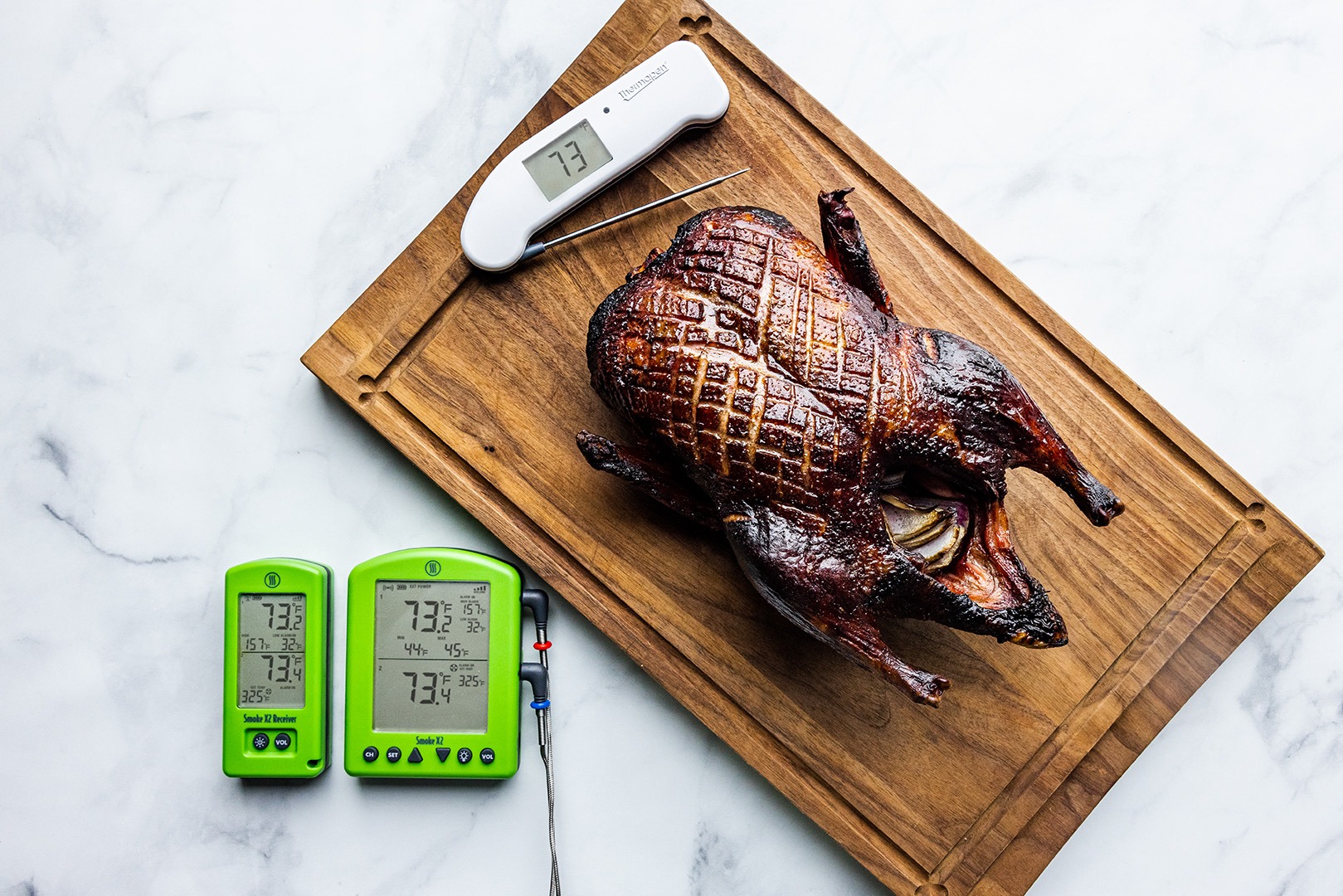


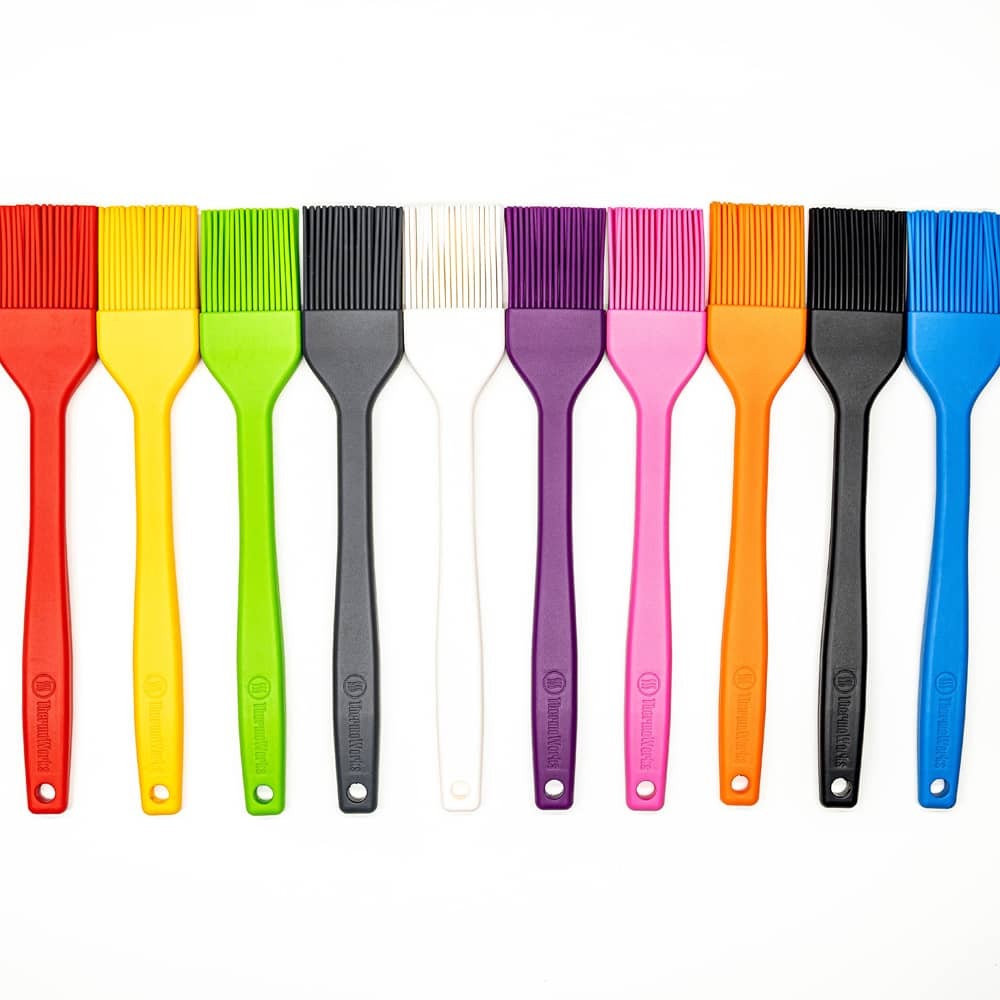
Can this recipe be used for goose as well?
Kelly,
Yes! The flavors in this recipe’s glaze will work well for goose too. Geese are typically 8-10 lbs. each, whereas ducks are about 5-6 lbs. It would be a good idea to smoke a goose in a lower temperature range, about 275-300°F.
Thanks!
-Kim
Goose only resembles duck by its look. The striking difference between these two birds is well known to anyone, who ever attempted to cook them by roasting them in the oven! I am reffering here to a domestic, farm raised species. Farm duckling naturally will have a lot more fat that will have to be rendered during the cookiing process. Goose has a lot less of fat and has also naturally drier meat.( there is of course a farm goose “force fed”to produce a prized liver for a pate in France that is exception). In my 50 years of trying to mimic results of of a rosted duck using tweeking times and temperatures on a goose every attempt failed. The mere fact, that a skinny goose commands price more than twice of a duck, it is a NO BRAINER! So good luck with your experiment, but the result may be closer to a goose jerky for sure.